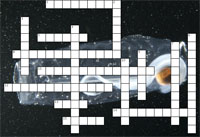|
Try the interactive puzzle » February 25, 2006 by Kate Madin “We do check-out dives to check things out,” said Larry Madin, “to make sure our systems and gear are working correctly, in the daylight.” Most of our diving will be at night, when salps are near the surface. Today the divers formed groups to do three practice dives before night diving begins in earnest. “We have eight divers with different backgrounds and experiences,” said Larry, who helped develop the scuba diving methods the team is using. “Only four have been in Antarctic waters before, and for some, it’s their first time doing ‘blue-water-dry-suit-night-diving.’” The divers struggled into dry-suit diving gear, the ship’s crew lowered an inflatable boat, divers and the marine technician climbed into it, and they drove away from the Gould. After attaching a “down-line” to an orange dive float, they jumped into the ocean, to hang suspended 15 meters (45 feet) down in “blue water,” far from shore. Blue-water diving is open-ocean research diving. For safety, they use a system of ropes and weights that fasten all divers together. Teams of three or four dive, with one person the ‘safety diver,’ watching for potential problems. The others, on 10-meter (30-foot) tethers, drift in the water, looking for salps to collect in plastic jars and bring back to the ship. “Daytime dives let us find the kinks to work out,” Kelly Rakow said after her dive. “There are layers of things to remember about diving here. It’s the little things you want to catch,” she said, “like having your glove twisted on the suit’s sleeve, which happened to me.” Byron Pedler was safety diver on the first dive. “There were definitely things to think about,” he said. “Many of us are using different gear than we trained in. We might have a different buoyancy compensator [vests to adjust diver buoyancy] or borrowed layers of clothing, and we don’t know how they’ll work at first. The first dive is to find that out.” “It was a good dive,” said Erich Horgan, dive program supervisor on this cruise, a diver with long experience. “There are many ways things could possibly fail, that we want to avoid. So we do these dives to test the gear and procedures together, and it went well.” Were they cold? “Your lips and mouth get bitterly cold,” said Sandy Williams. “But it’s no colder than skiing.” “It’s surprising how warm it was,” Bryon added. “I expected –1.8 degrees C, and it’s up around 2!”
|
|||||||||||||||||||||||||||||||||||||||||||||||||||||||||||||||||||||||||||||||||||||||||||||
Mailing List | Feedback | Glossary | For Teachers | About Us | Contact
© 2010 Dive and Discover™. Dive and Discover™ is a registered trademark of Woods
Hole Oceanographic Institution





